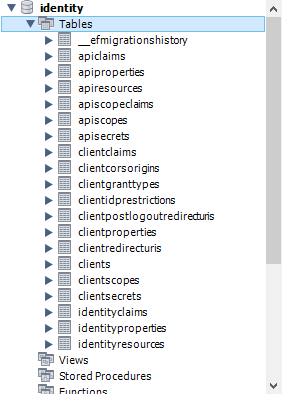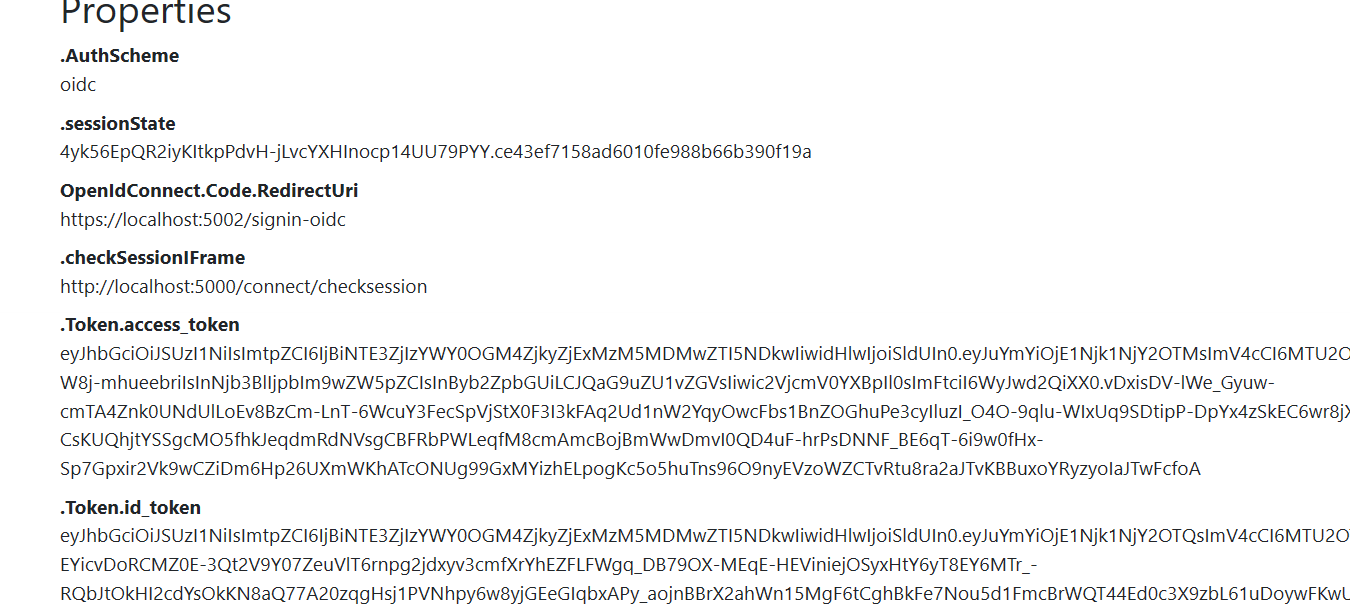IdentityServer4结合Mysql
上一篇:IdentityServer4使用OpenIdConnect实现单点登录。
前面写的示例中,IdeneityServer使用的是内存缓存的存储方式,所有的配置都写在Config.cs里。在实际应用中,应该使用数据库存储方式,方便随时配置,如添加新的用户、资源、客户端,也可以节省服务器内存。
本文从三个方面来实现IdentityServer4结合Mysql实现数据库存储方式,分别是客户端及资源数据、令牌及授权码数据以及用户数据。
一,准备内容
1,准备MySql数据库服务器,新建一个空的数据库
2,IdentityServer需要安装以下几个程序包。
IdentityServer4.EntityFramework Microsoft.EntityFrameworkCore.Tools Pomelo.EntityFrameworkCore.MySql(也可以用MySql官方程序包:MySql.Data.EntityFrameworkCore)
3,appsettings.json添加数据库连接字符串
{
"ConnectionStrings": {
"MySqlDbConnectString": "server=IP;userid=mysqlUserName;pwd=user's password;database=database name;connectiontimeout=30;Pooling=true;Max Pool Size=300; Min Pool Size=5;"
}
}
二,客户端及资源的数据库存储
前面我们使用AddInMemory的方式加载配置数据
AddInMemoryIdentityResources(Config.GetIdentityResources()) AddInMemoryApiResources(Config.GetApis()) AddInMemoryClients(Config.GetClients())
把这三行代码注释掉,以下代码替换
var connection = Configuration.GetConnectionString("MySqlDbConnectString");
var builder = services.AddIdentityServer()
//身份信息资源
//.AddInMemoryIdentityResources(Config.GetIdentityResources())
.AddConfigurationStore(opt =>
{
opt.ConfigureDbContext = context =>
{
context.UseMySql(connection, sql =>
{
sql.MigrationsAssembly("IdentityServer");
});
};
})
.AddTestUsers(Config.GetUsers());}
要从数据库查询配置数据,肯定得添加相应的数据表,把IdentityServer项目设为启动项目,打开程序包管理器控制台,设置控制台默认项目为IdentityServer,在控制台输入以下指令
PM> add-migration ConfigDbContext -c ConfigurationDbContext -o Data/Migrations/IdentityServer/PersistedGrantDb To undo this action, use Remove-Migration. PM> update-database Done.
-c ConfigurationDbContext是指定当前的数据库上下文。ConfigurationDbContext定义在命名空间: IdentityServer4.EntityFramework.DbContexts,和昨们使用CodeFirst一样,定义了客户端及资源的数据表及表关联。add-migration生成迁移变动记录,update-datase更新数据库到最新状态。

但是现在数据库中的客户端和资源数据都是为空的,需要把Config的配置数据添加到数据库,可以在Start.cs中添加方法进行数据库初始化
private void InitializeDatabase(IApplicationBuilder app)
{
using (var serviceScope = app.ApplicationServices.GetService<IServiceScopeFactory>().CreateScope())
{
var context = serviceScope.ServiceProvider.GetRequiredService<ConfigurationDbContext>();
if (!context.Clients.Any())
{
foreach (var client in Config.GetClients())
{
context.Clients.Add(client.ToEntity());
}
context.SaveChanges();
}
if (!context.IdentityResources.Any())
{
foreach (var resource in Config.GetIdentityResources())
{
context.IdentityResources.Add(resource.ToEntity());
}
context.SaveChanges();
}
if (!context.ApiResources.Any())
{
foreach (var resource in Config.GetApis())
{
context.ApiResources.Add(resource.ToEntity());
}
context.SaveChanges();
}
}
}
说明:利用app.ApplicationServices.GetService<IServiceScopeFactory>().CreateScope创建一个新的服务作用域与其他作用域隔离开,不影响其它作用域的上下文释放,操作实体更新数据库和我们平时用的一样。运行程序后,发现数据库已经有数据了

运行IdentityServer,IdentityMvc,IdentityApi三个程序进行测试

二,令牌和授权码的数据库存储
利用IIdentityServerBuilder的扩写方法AddOperationalStore
//客户端及资源数据库存储配置
.AddConfigurationStore(opt =>
{
opt.ConfigureDbContext = context =>
{
context.UseMySql(connection, sql =>
{
sql.MigrationsAssembly("IdentityServer");
});
};
})
//令牌及授权码数据库存储配置
.AddOperationalStore(opt =>
{
opt.ConfigureDbContext = context =>
{
context.UseMySql(connection, sql =>
{
sql.MigrationsAssembly("IdentityServer");
});
};
opt.EnableTokenCleanup = true;
opt.TokenCleanupInterval = 30;
})
.AddTestUsers(Config.GetUsers());
同样的,需要添加用来存储的数据表
PM> add-migration OperationContext -c PersistedGrantDbContext -o Data/Migrations/IdentityServer/OperationDb Multiple startup projects set. PM> update-database -c PersistedGrantDbContext Done.
运行IdentityServer,IdentityMvc,IdentityApi三个程序进行测试

三,用户的数据库存储
IdentityServer4为IIdentityServerBuilder提供了支持客户端和资源数据库存储的AddConfigurationStore方法,支持令牌和授权码数据库存储的AddOperationalStore,但没有提供用户数据库存储的方法。不过提供了一个“IdentityDbContext”数据上下文。我们可以基于这个来实现。
新建一个Dbcontext,继承于IdentityDbContext。IdentityDbContext的set中已经加入了identity中用户和角色的相关实体。我们可以基于这些实体扩展,比如丰富用户实体的数据内容。
1,建立需要扩展的实体类。如:
public class LiujbUser:IdentityUser
{
//实体自定义字段
public string Custom { get; set; }
}
2,将自定义的实体加入到Dbcontext的Set集合中
public class ApplicationDbContext: IdentityDbContext
{
public DbSet<LiujbUser> LiujbUsers { get; set; }
public ApplicationDbContext(DbContextOptions<ApplicationDbContext> opt) : base(opt) { }
}
3,将自定义的数据库上下文在startup中注册
services.AddDbContext<ApplicationDbContext>(opt => {
opt.UseMySql(Configuration.GetConnectionString("UserConnection"));
});
4,更改Identity中关于用户和角色的处理到Entityframework
services.AddIdentity<LiujbUser, IdentityRole>()
.AddEntityFrameworkStores<ApplicationDbContext>()
.AddDefaultTokenProviders();
5,用add-migration init -c ApplicationDbContext -o Data/Migrations/IdentityServer/AppDb 以及update-database -c ApplicationDbContext 更新用户到数据库

6,在数据库初始方法中添加Config类中的用户初始化数据
private void InitializeDatabase(IApplicationBuilder app)
{
using (var serviceScope = app.ApplicationServices.GetService<IServiceScopeFactory>().CreateScope())
{
var applicationDbContext= serviceScope.ServiceProvider.GetRequiredService<ApplicationDbContext>();
IdentityRole role = null;
if (!applicationDbContext.Roles.Any())
{
role = new IdentityRole()
{
Name = "admin",
NormalizedName = "admin"
};
applicationDbContext.Roles.Add(role);
}
else
{
role = applicationDbContext.Roles.Where(r => r.Name.Equals("Admin")).SingleOrDefault();
}
if (!applicationDbContext.Users.Any())
{
var user = new LiujbUser()
{
UserName = "administrator",
PasswordHash = "admin123456".Sha256(),
Email = "liujb@xx.com",
NormalizedUserName = "admin"
};
applicationDbContext.UserClaims.Add(new IdentityUserClaim<string>()
{
ClaimType = ClaimTypes.Country,
ClaimValue ="CSC",
UserId = user.Id
});
applicationDbContext.Set<LiujbUser>().Add(user);
if (role != null)
{
applicationDbContext.UserRoles.Add(new IdentityUserRole<string>()
{
RoleId = role.Id,
UserId = user.Id
});
}
}
await applicationDbContext.SaveChangesAsync(); } }
}
Identity封闭了两个管理类UserManager和RoleManager,对用户和角色的操作进行了封装,使用更为方便。


